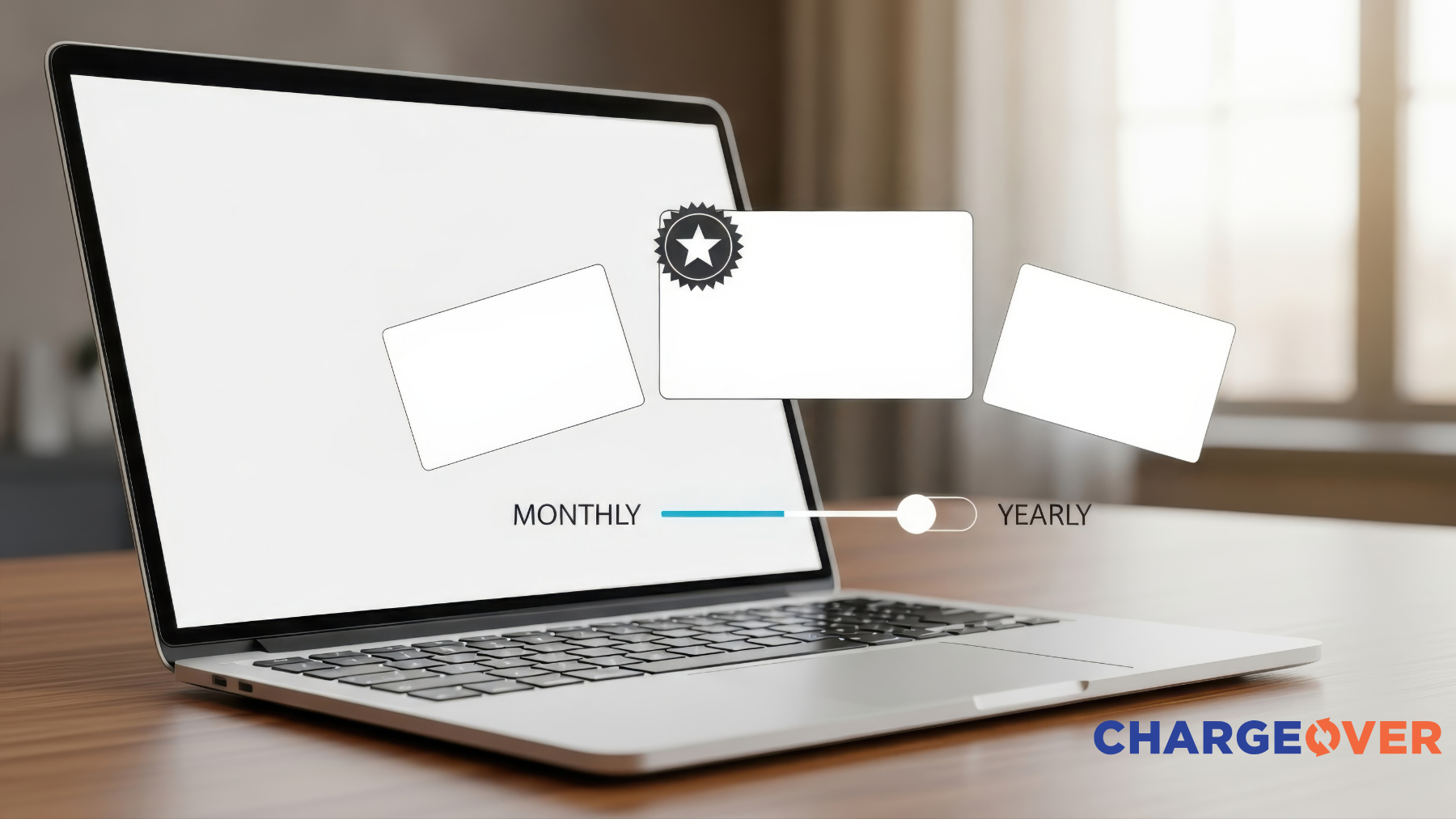Given the dynamic nature of the business landscape, companies are constantly seeking innovative ways to optimize their pricing models and cater to evolving customer needs and expectations. One innovative approach gaining traction is consumption-based pricing.
In this blog post, we discuss consumption-based pricing, exploring its impact on businesses, its key benefits, and practical considerations for successful implementation. We'll also show you how ChargeOver's powerful billing system can simplify the process and ensure accurate invoicing for your usage-based services.
Main takeaways from this article:
- Consumption-based pricing models adapt to customer use, offering flexibility and aligning costs with actual usage.
- This approach enhances customer satisfaction and can drive revenue growth by matching service value with pricing.
- Implementing this model requires overcoming challenges such as usage tracking and pricing plan complexity.
- Understanding and managing consumption-based pricing can reduce entry barriers and encourage long-term client relationships.
- ChargeOver's automated invoicing system streamlines billing processes, ensuring accuracy and efficiency in usage tracking.
What is consumption-based pricing?
Consumption-based pricing, also known as usage-based pricing, breaks away from the traditional "one-size-fits-all" approach of subscription billing. Instead of charging a fixed fee for access to a product or service, customers pay only for what they use. This approach complements the growing preference for flexibility and transparency in today's consumer and B2B markets and is well-suited for products and services with fluctuating usage patterns, such as storage solutions and on-demand services.
Common consumption-based pricing models

With its growing popularity, several variations of consumption-based pricing have emerged, each catering to specific business needs and customer preferences. Here are some common models:
Pay as you go
This straightforward model charges customers per unit of usage, like paying per gigabyte of data storage or per minute of cloud computing time. It's ideal for services with highly variable usage patterns and offers complete transparency for customers.
Tiered
Tiered pricing structures categorize usage into predetermined levels (tiers), each with a different price per unit. This model provides a balance between cost control and flexibility for customers. Users who consistently fall within a specific tier can benefit from discounted rates.
Usage
Similar to pay-as-you-go, usage pricing charges customers based on their overall consumption within a billing cycle. This can be applied to things like storage space or API calls. The unit price may remain constant or vary based on usage volume.
Volume
This model charges customers based on the total amount of a service or resources they consume within a specific timeframe, regardless of individual usage units. For instance, a cloud storage provider might offer a discount for users who consistently upload large datasets.
Overage
This model combines a base fee with additional charges for usage exceeding a predetermined threshold. It’s ideal for scenarios where some base-level usage is expected, but customers have the flexibility to pay for occasional spikes in demand.
Hybrid
Many businesses, especially SaaS companies, combine elements of different models to create a customized pricing structure. For example, a cloud service provider might offer tiered pricing for storage while also implementing pay-as-you-go for computing power, creating a hybrid approach.
How consumption-based pricing impacts businesses

Transitioning from fixed-fee models to consumption-based pricing can have a significant impact on businesses in several key areas, including:
Revenue predictability and variability
Subscription-based revenue forecasting can be variable compared to fixed subscription fees. The variable nature of subscription revenue is due to several factors, such as customer churn, seasonal fluctuations, and changes in usage patterns.
However, accurate usage tracking and pricing strategies can provide valuable insights into customer behavior and usage patterns. This information can help you make more informed revenue forecasts over time.
Customer satisfaction and engagement
Consumption-based pricing is a model in which customers pay for a service or product based on how much they use it. Customers prefer this model to other pricing models because it is fair and transparent.
When customers pay only for what they use, it gives them a sense of control over their budget and helps them optimize resource allocation. This directly translates into increased customer satisfaction and engagement.
Flexibility and scalability for growth
Consumption-based pricing allows businesses to scale easily. It can accommodate customers with limited budgets or unpredictable needs while also supporting the business's scalability.
High-volume users can pay for increased usage, and infrequent users aren't penalized for low consumption. This flexibility lays the groundwork for sustainable growth without limiting your potential customer base.
Key benefits of the consumption-based pricing model

There are compelling reasons to consider consumption-based pricing for your business model. Here are some of the key benefits you can reap:
Aligns customer value with pricing
The value-based approach to pricing ensures that customers are only charged for the value they receive from your product or service. This approach creates a sense of fairness and transparency, which leads to increased customer retention and loyalty.
The model also provides a mechanism for continually improving your product or service, as you are constantly striving to provide more value to your customers.
Encourages cost efficiency
Consumption-based pricing helps businesses save money by matching costs to actual usage. They gain better control over their finances and can grow according to their needs without extra incurring expenses.
Customers can also manage their usage to save money. The clear connection between cost and usage makes it easier to budget. By using resources wisely, both suppliers and consumers reduce waste and find better financial solutions, supporting sustainable practices and long-term value.
Reduces barriers to entry
Offering a consumption-based pricing model provides an attractive opportunity for prospective customers to engage with your product or service without making a significant initial investment.
By removing the financial hurdle associated with traditional fixed-cost pricing, you make your offerings appeal to more prospective clients. This makes customer acquisition easier and also increases market penetration, as people are more likely to try a service that aligns cost with their actual usage patterns.
Promotes long-term customer relationships
In the consumption-based pricing model, customers pay for exactly what they use. This builds trust because they appreciate the fairness and transparency of knowing what they are paying for. Businesses also benefit by cultivating strong customer loyalty and by aligning the price with the perceived value.
This model encourages you to use resources carefully, which boosts satisfaction and can result in long-term positive relationships.
Challenges in implementing consumption-based pricing
While the consumption pricing model offers several benefits, it also comes with its own set of challenges. Here are some key considerations to keep in mind:
Accurately tracking and measuring usage
Implementing this model requires a robust system to accurately track and measure customer usage. This can be complex, especially for services with multiple usage dimensions or dynamic pricing structures.
For example, a service provider might offer different pricing options based on the time of day, the day of the week, or the time of year. This would require a system that can accurately track and measure usage across all dimensions.
Revenue predictability
As we mentioned, consumption-based pricing can introduce some variability in revenue forecasting. While this can be managed with effective planning and analysis, it may require adjustments to your financial projections. It's essential to continuously monitor market trends and customer behavior to anticipate and mitigate these fluctuations.
Higher upfront setup costs
Consumption-based pricing is attractive to customers because they pay only for what they use. For businesses, implementing consumption-based pricing can involve higher upfront costs than a fixed-fee model. These costs include developing the necessary infrastructure and software to track usage and generate accurate invoices.
Managing usage spikes
Sudden spikes in usage can impact your revenue and resource allocation. This is especially true if you are not prepared to manage the fluctuations. To address this challenge, it is essential to have strategies in place. These strategies can include tiered pricing or overage charges.
Risking customer loyalty
While consumption pricing offers flexibility and aligns with customer value, it's important to monitor it closely. By understanding how customers use your product, you can ensure the pricing model stays fair and competitive. If you don't monitor it well, customers might become dissatisfied and leave. Finding the right balance by regularly adjusting prices is necessary.
How to implement consumption-based pricing models

If you're ready to adopt a consumption-based pricing model for your business, here are some practical steps to guide your implementation:
Identify usage metrics
Determine the key metrics that will be used to measure customer usage. These metrics should be relevant to your product or service and easy to track. For example, a cloud storage provider might use gigabytes of storage as a usage metric, while a SaaS company might track the number of active users or API calls.
Set clear pricing rules
Establish clear pricing rules, including the unit of measurement, pricing tiers, and any additional fees or discounts that may apply. Ensure that the pricing structure is transparent and easy to understand. For instance, a cloud storage provider might offer tiered pricing with discounted rates for higher storage volumes.
Automate usage tracking and invoicing
Invest in technology that automates usage tracking and billing processes. This will save time and reduce errors, ensuring accurate and timely invoicing. Look for billing systems that can handle complex usage calculations and generate detailed invoices based on customer consumption.
Monitor and adjust pricing strategies
Continuously monitor customer usage patterns and market trends to evaluate the effectiveness of your pricing strategy.
Be prepared to make adjustments as needed to optimize revenue and customer satisfaction. If you notice a significant increase in usage during certain periods, you might consider introducing peak pricing to balance demand and revenue.
Simplify billing with ChargeOver's automated invoicing system
Implementing consumption-based pricing can be a breeze with the right tools in place. Here's where ChargeOver comes into play.
As a powerful billing system designed to support various pricing models with its automated invoicing features, ChargeOver simplifies the billing process for your usage-based services, ensuring accurate and timely invoicing.
Here's how our platform simplifies consumption-based billing:
- Automated usage tracking and invoicing: ChargeOver automates the entire process of tracking customer usage and generating accurate invoices. This eliminates manual data entry and reduces errors, saving you valuable time and resources.
- Flexible usage-based billing: Easily configure different pricing models within ChargeOver, including pay-as-you-go, tiered pricing, overage charges, and more. This flexibility allows you to create a pricing structure that perfectly aligns with your business needs and customer preferences.
- Real-time usage tracking: Gain real-time insights into customer usage patterns. This valuable data can be used to optimize your pricing strategy, identify potential revenue opportunities, and ensure customers are billed accurately.
- Customer self-service portal: Empower your customers with a self-service portal where they can view their usage data, access invoices, and manage their subscriptions. This will promote transparency and foster a sense of control for your customers.
By leveraging ChargeOver's automated invoicing system, you can remarkably reduce your administrative workload and focus on growing your business.
To learn more about how we can help your business, contact our team or request a Demo now!
Transform Your Billing Experience
Your results are just the beginning. Learn how to optimize your billing and scale your success.
FAQ
What is the difference between consumption and usage-based pricing?
Although the two terms are often used interchangeably, there are subtle differences. Consumption-based pricing focuses on the overall value a customer derives from a product or service, while the usage-based pricing model specifically measures the quantity of a resource consumed.
Why would someone prefer a consumption-based pricing model?
Customers often prefer consumption-based pricing because it offers greater flexibility, transparency, and fairness. They pay only for what they use, avoiding unnecessary costs and feeling more in control of their expenses. Plus, the consumption-based model can reduce the barriers to entry for new customers, making it easier to try out a product or service.


